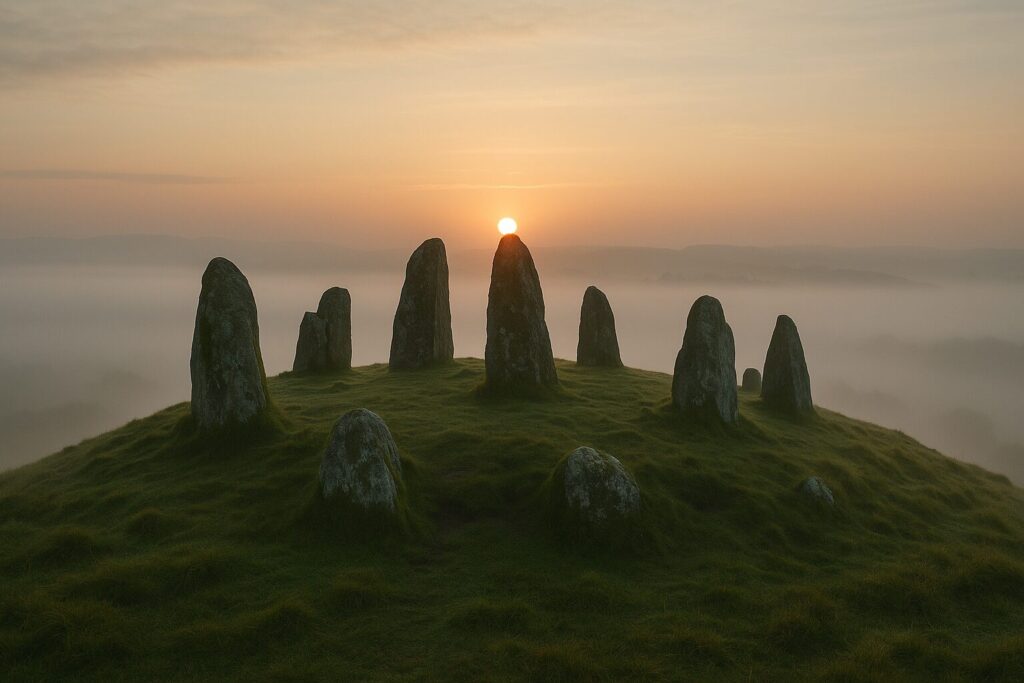In the Shadow of Old Stones
Kael’s Perspective on Modern Pagan Reconstruction and Sacred Synchronicity
A personal meditation, welcomed by the Coven as one voice among many, for each path finds its own truth in the presence of the Gods.

I have never claimed to walk in the exact footprints of the ancients. The gods of old do not require imitation—they require presence. For me, Neopaganism is not a revival of the past but a sacred approximation: a weaving together of myth, memory, and modern intuition. I do not stand as a fundamentalist guarding forgotten temples, but as a mystic scholar listening for their echoes in the wind.
From the worn stones of old circles to the surviving etymologies of divine names, I approach Neopaganism as an act of reverent reconstruction. My practice is neither archaeology nor invention, but a devotional synchronism—a layering of fragments, languages, and resonances that aims not only to remember, but to reconnect.

The prefix neo- has never embarrassed me. It is a mark of honesty. The ancient faiths of the Indo-European world—whether Celtic, Hellenic, Norse, or Slavic—did not survive whole. There is no unbroken priesthood, no singular canon, no orthodoxy preserved in amber. What we have are stones, songs, laws, and folk memory. As Ronald Hutton wrote in The Triumph of the Moon, “The Pagan past survives less in its doctrines than in its poetic residue.” I live and work within that residue, drawing out what still breathes.
I do not claim to revive the old ways as they were. Instead, I seek to build a meaningful spiritual grammar from their remains. When I call upon Lugh, Helios, or Apollo, I do not see them as the same god, but as radiant expressions of a shared solar principle—distinct yet interconnected. Their names form a chord. Their stories, a harmony.

Unlike the monotheisms that hinge upon obedience and salvation, my Paganism is relational. I honor the gods not because they command me, but because they are worth honoring. The divine, to me, is multiple and emergent—never jealous, never fixed. My reverence is not submission. It is dialogue.
I often return to John Michael Greer’s reminder: “The gods are not abstract ideals. They are persons in the deepest sense—mysterious, autonomous, powerful—but also approachable.” I have found that to be true. The gods are not ideas to be studied but presences to be encountered.
My path leans heavily on linguistics, mythography, and comparative religion. Dumézil’s tripartite theories, Gimbutas’s goddess symbology, and the mythic migrations of divine archetypes—all of these inform how I understand the gods’ many faces. But the goal is not to flatten difference; it is to trace relationship.
Hekate is not Brigid—but both dwell at the threshold, at the fire’s edge, where illumination meets shadow. It is there that I find them, not as reconstructions, but as living currents.

Syncretism, for me, is not confusion—it is consecration. When I blend structures, offerings, or call a deity by title, I do so as a musician layering instruments. It is not theology—it is poetry. And in poetry, harmony emerges through tension.
My altar shifts with the wheel of the year. At solar sabbats I offer light and verse; at lunar esbats I walk the circle and light a torch in Hekate’s name. I never believe magic compels the gods—it invites them. My rituals are not transactions, but recognitions. I seek presence, not power.
Ritual is a language. Structure gives form to reverence, and through that form the divine speaks. In this balance—between order and ecstasy, intention and intuition—the Apollonian and Dionysian meet. That paradox is where I live.

I recognize that Neopaganism holds many identities. For me, it is the wide forest. Wicca is one of its sacred groves—an initiatory mystery tradition born of Gardner and his heirs. Witchcraft is a craft, a praxis, often secular or solitary. I respect them all, but my own trail winds between.
Paganism is not a church. It is a forest. Each of us must know our trail, but the forest belongs to all who walk it in truth.
I do not pretend certainty. There are gaps, contradictions, bridges of speculation. Yet those liminal spaces—between torchlight and mist—are where meaning takes root.
I do not worship ruins. I walk among them and speak. The gods are not relics; they are breath and thunder, water and word. My Paganism is not a return—it is a reweaving. Not a dogma, but an encounter.
When I honor them, I am honored in return. When I speak their names, I listen for the whisper that answers—sometimes a murmur, sometimes a cry. For me, Paganism is relationship, and relationships—like gods—endure only through presence.

Understanding Pagan Paths
Three threads, often woven together: relationship with the Gods, the daily work of living Pagan, and the philosophies that underlie both. Follow the path that calls, or wander all three.
Visit the Paganism HubStep One: Connecting with the Gods
Meet the deities, their stories, and the many ways witches build relationship with the Gods.
Step Two: Living Pagan
Explore how Pagan practice weaves into daily life—ethics, seasons, altars, and ordinary magic.
Step Three: Mystical Currents
Dive into polytheistic philosophies, theology, and the deeper currents beneath Pagan practice.
Discover of Pagan Wisdom

